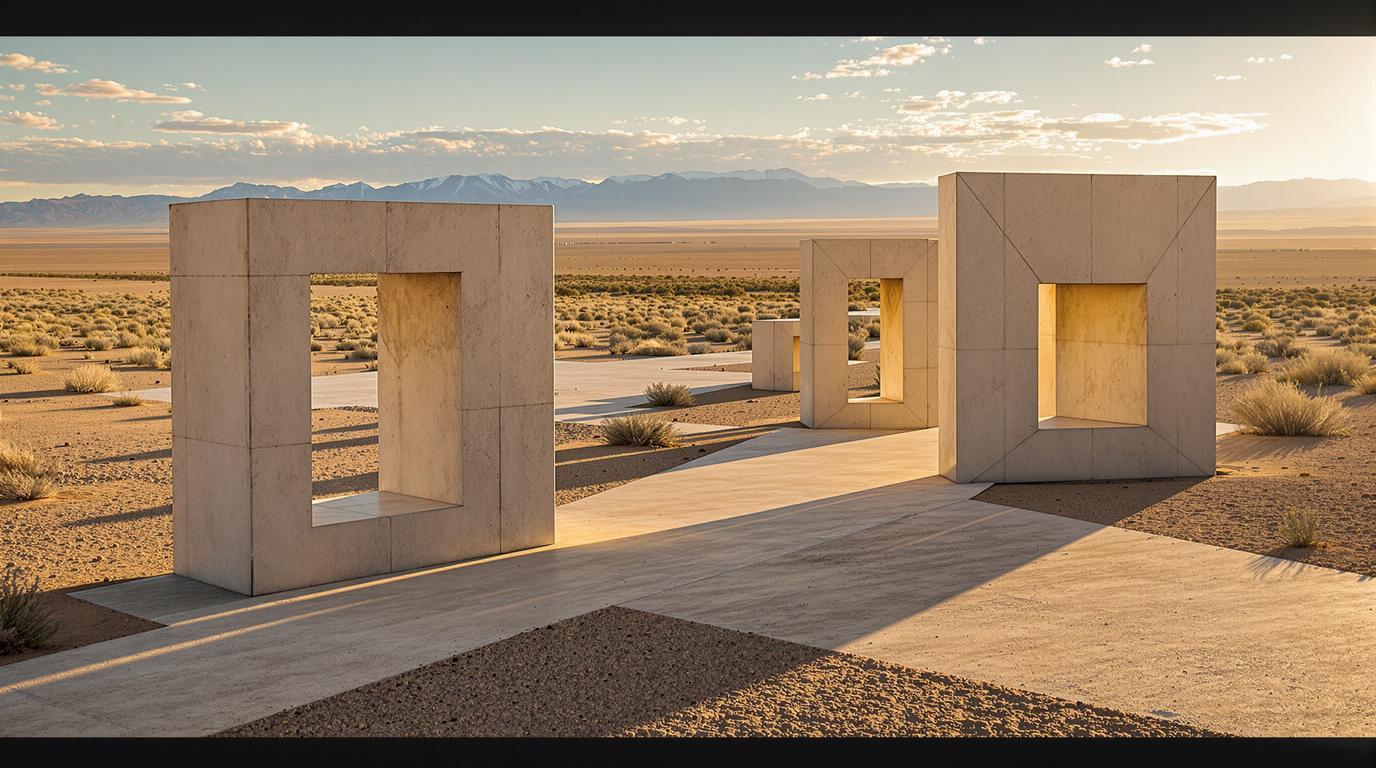Standing at 1,434 meters above sea level in the Chihuahuan Desert, I watched the sun set behind Donald Judd’s concrete installations, realizing most visitors rushing through Alpine miss this profound artistic transformation. This remote Texas town of 1,800 residents has quietly become America’s most authentic art sanctuary, where minimalist sculptures merge with endless desert horizons. While tourists flock to predictable galleries in Santa Fe or Sedona, Marfa guards its secrets like a protective ranching family – welcoming but selective about who truly understands its magic.
The town’s artistic revolution began in the 1970s when Donald Judd abandoned New York’s commercial art world for this forgotten railroad stop. Today, his legacy lives through the Chinati Foundation, where massive concrete boxes catch desert light in ways no indoor gallery could replicate. Yet most Alpine visitors, just 26 miles away, never venture into this cultural oasis that redefines contemporary art.
What strikes you immediately isn’t just the art – it’s how ranching heritage and avant-garde installations coexist without compromise. Local families who’ve worked this land for generations share coffee with international artists, creating an authenticity that feels increasingly rare in America’s cultural landscape.
The desert art sanctuary that transforms minimalism into spiritual experience
Where concrete meets infinite sky in perfect harmony
The Chinati Foundation’s 340-acre campus showcases Judd’s revolutionary vision – 100 milled aluminum boxes that capture changing light throughout the day, creating what locals call “meditation in metal.” These installations, accessible only through guided tours, transform minimalist art from sterile gallery pieces into profound desert experiences. The foundation limits visitors to preserve this contemplative atmosphere, making each visit feel like discovering a hidden monastery dedicated to artistic enlightenment.
Hidden installations locals keep to themselves
Beyond the famous Prada Marfa sculpture, insiders know about Judd’s private studio spaces scattered throughout town, many still occupied by working artists who maintain the founder’s vision. The locals protect these spaces like family secrets, sharing access only with visitors who demonstrate genuine appreciation for the artistic process rather than Instagram opportunities.
Authentic ranching culture that survived the art world invasion
Where centennial families welcome contemporary artists
Unlike gentrified art destinations, Marfa’s ranching families never left – they adapted. At the town’s weekly cattle auctions, you’ll find conceptual artists bidding alongside fourth-generation ranchers, creating cultural exchanges that feel organic rather than forced. This authentic artistic community emerges from mutual respect rather than cultural displacement.
The Mexican border influence tourists overlook
Just 60 miles from Mexico, Marfa’s cultural identity extends far beyond minimalist art. Local restaurants serve authentic border cuisine that influenced visiting artists’ work, while Spanish conversations mix naturally with art theory discussions. This bilingual, bicultural reality creates artistic inspiration that purely Anglo art colonies lack entirely.
The exclusive experience that’s disappearing faster than locals admit
Why 2025 marks Marfa’s transformation tipping point
Recent James Beard nominations for local restaurants and new digital art galleries signal Marfa’s evolution from insider secret to mainstream destination. Hotel Saint George’s restoration and El Cosmico’s expansion accommodate growing visitor numbers, but old-timers worry about losing the intimate scale that made artistic encounters so personal and meaningful.
The dark sky preserve that creates artistic magic
Marfa’s location in one of America’s darkest sky preserves isn’t coincidental – Judd chose this spot partly for its pure light quality. The mysterious Marfa Lights phenomenon adds another layer to the town’s artistic mystique, where natural and human-created beauty merge in ways that nearby Alpine’s mountain beauty cannot replicate.
Insider access and seasonal secrets for authentic discovery
When to visit for maximum artistic impact
Spring and fall offer ideal conditions for experiencing outdoor installations, with temperatures averaging 65°F compared to July’s challenging 90°F heat. Chinati Foundation tours require advance booking, especially during cooler months when installations shine without desert heat distortion affecting the viewing experience.
Local connections that unlock hidden experiences
Wednesday through Sunday visits maximize access to galleries and restaurants, but locals recommend arriving Tuesday to witness the town’s quieter rhythm. Ranch families often share stories about pre-art Marfa over coffee at convenience stores, providing cultural context that transforms artistic appreciation into deeper understanding.
Travel Note: “During my week in Marfa, I discovered that the most profound artistic moments happened not in galleries but during conversations with ranchers who watched their hometown transform while maintaining its essential character – a balance increasingly rare in American cultural destinations.”
Standing in Marfa’s town square as stars emerge above Judd’s installations, you realize this desert sanctuary offers something no traditional art destination can provide – authentic cultural evolution rather than manufactured artistic experience. The town’s growing recognition threatens this exclusivity, making 2025 perhaps the last year to experience Marfa’s perfect balance of artistic innovation and ranching authenticity. While Alpine tourists rush toward Big Bend’s natural wonders, those who discover Marfa’s artistic desert find something equally profound but infinitely more rare in modern America.
